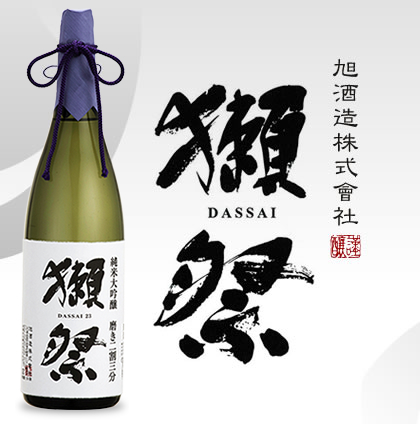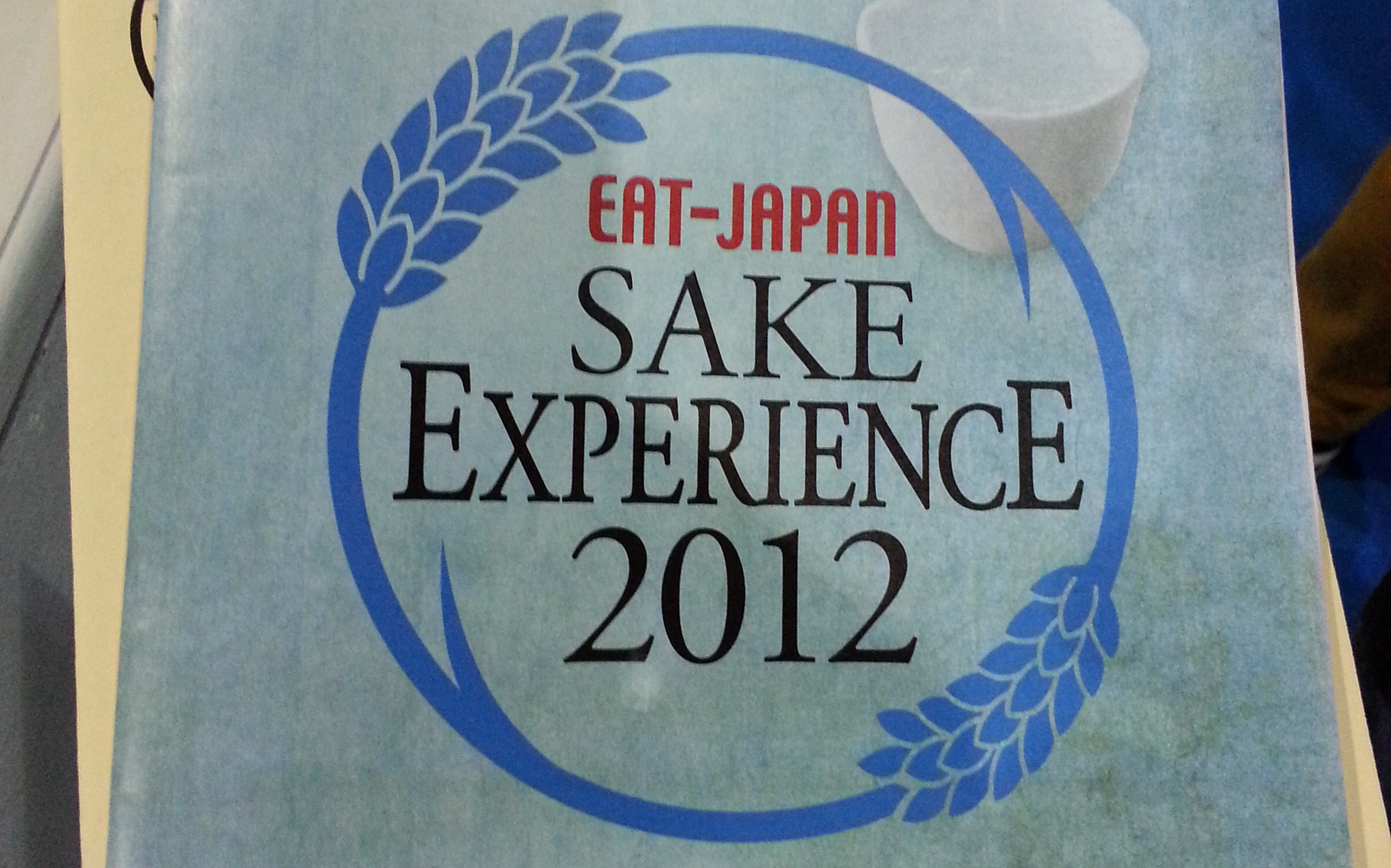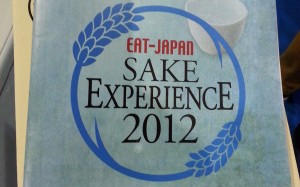On our recent trip to the Hyper Japan Show held at Earls Court between 23-25th November 2012, I had the opportunity to sample the delights of what the Land of the Rising Sun has to offer. This came not only in terms of food, gadgets, fashion and culture, but also in one my infrequent tipples; Sake!
Now, for anyone who knows me, I am not renowned for being a large drinker (others may instead say it is more case of someone who cannot hold their drink), so any spirit based drink is going to go to my head quite quickly. I have really only drank sake on a handful of occasions, but I have found it a different and agreeable drink, especially when I have taken it warm, but usually I only every do this when I have gone to a Japanese restaurant. However, when my wife, Annie, gave me a free pass to let me try out Eat Japan The Sake Experience, she need not offer twice, and not before long I was queuing up having passed over my £15 to try. Later, she would regret me doing this, as going around the table and sampling the 21 varieties of sake and other beverages available would take over an hour.
Before going into some of the sake, a quick word about three categories of sake, known as Junmai, Ginjo and Daiginjo, as taken from sake-world.com:
Junmai-shu
Made with only rice, water and koji mold. The rice used must be polished to at least 70%**. Often a full and solid flavour profile, clean and well structured.
Junmai Ginjo-shu
Brewed with labor-intensive steps, eschewing machinery for traditional tools and methods, using highly polished rice (at least 60%**) and fermented at colder temperatures for longer periods of time. Light, fruity, refined.
Junmai Daiginjo-shu
A subclass of junmai ginjo-shu, brewed with very highly polished rice (to at least 50%** ) and even more precise and labour intensive methods. The pinnacle of the brewers’ art, this type of sake is generally light, complex and fragrant.
It gets more complicated than this, as these are also sister categories that have added alcohol, making up what are known as the “premium” sake, which constitutes only 20% of sake produced. Anyway, this isn’t a sake lesson here so if you are more interested about it read up about it on Sake World. Now, on with the drinking!
Dassai 23

This sake was the first one samples I tried upon arriving to the Sake Experience, and it was proclaimed to be “the finest sake in the world” by the husband of Kaoru Lida, European Correspondent for Asahi Shuzo, and at a quoted £100 a bottle I would have expected nothing less. As something of a non-connoisseur, paying such prices for any consumable seems unfathomable for me. Yet despite this, from the very start the sake was clean and pristine, and went down nice – too nicely for its price.
As its name indicates, the number 23 is important here as it is what is referred to as the milling rate; that is, to what degree the rice has been “polished” for fermentation. The lower the percentage of the rice used, then the subtler the flavour and more finesse the texture of the sake has.
Junmashishu Urakasumi
Even as a non-connoisseur like myself, the nose of pech and melon http://www.eta-i.org/provigil.html were conspicuous in this sake. Said to be a great accompliment to seafood, this was an enjoyable sake made by the Urakasumi Sake Brewery established in 1724 in Miygi. With a higher rice polish ratio and sat next to the ultra-premium Dassai 23, this was notably less subtly, but had a more unique taste.
Okunden Kantsukuri

The Okunden Kantsukuri sake was created by Miyasaka Brewing from Nagano (of Winter Olympics fame), and was a subtle sake on the palate.
Umenoyado Aragoshi Umeshu & Umenoyado Yuzushu
These are not sake but instead umeshu, an ume plum and lemon wine repectively, created by the Umenoyado Brewery from Nara using the waters of the Katsuragi mountains. I found the lemon Umenoyado Yuzush to be very distinct sharp and tangy, but couldn’t imagine drinking more than a small amount at a time. The plum Umenoyado Aragoshi Umeshu was a lot smoother.
Kawatsuru Junmaindaiginjo Fukurosibori Mukora

A handful to say and a higher alcohol percentage meant that this sake by Kawatsuru Sake Brewing was better for eating sashimi and meat with rather than supping on its own, so no doubt I did not get the best from it.
Kimoto Junmai

This was a curious sake by Sho Chiku Bai Shirakabegura (here for english) was different for its lactic acidity. Drinking it was very flavoursome and made your mouth water, making me hanker for a handful of rice crackers to go with it.
MIO Sparkling Sake
Also by a href=”http://shirakabegura.jp/index.htm” title=”Shirakabegura (japanese only)” target=”_blank”>Sho Chiku Bai Shirakabegura, this was a ver quaffable drink made from sake, which at 5% may not be as strong as a “grown up” sake, but was very quaffable. Highly recommended for sake beginners!
Maibijin Junmaishu
This junmai sake was quoted as having a “woody, earthy and punchy” flavour using a shibori process using a wooden press, and indeed that hit my taste buds for a distinct flavour. By Mikawa Syuzoujyou, a small brewery located in east Fukui city, this sake can be served chilled, at room temperature, warm or hot.
Junmaidaiginjou Sanjurokuninshu
As my notes tell me, this premium Daigingo sak was my favourtite out of all of the sake on offer, though quite how i could remember having gone through so many by this point I do not know. At a far more affordable cost, this sake by Kikuisami, who also produce the award-winning junmai sake Dewanosato Sanjurokuninshu. This one however is normally served ice cold and I loved it for its aperitif properties.
Tokubetsu Junmai
Created by Nanbu Bijin, this sake is brewed completely from locl ingredients including ginginga sake rice. Said to be a universal accompliment for all foods, I enjoyed this one immensely.
Golden Amber
This sake is kept in tanks for 12 years, and as an aged sake, it had the most ditinctive flavour out of all of those I tried that day. Created by Hayashihonten, the president of the company Rieko Hayashi served me himself this delightful drink.
Nearing the end
Well thats it for the sake sampling. I found it a great experience, indeed I met two very nice fellows as we journied around the stalls in the form of Robert and Stanislav. We all had a great time, and I hope my next taste of sake will be a much more cultured one. You can purchase some of thes eitems from Eat Japan should you be interested.


